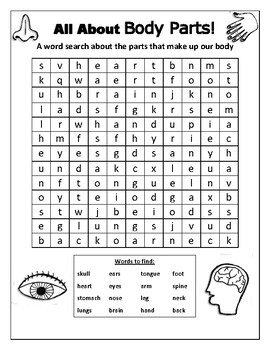

Raw foods are more beneficial as dietary sources of vitamin C. Vitamin C is sensitive to heat, so some of its nutritional benefits can be lost during cooking.
#Word search 4. used in body functions free
Antioxidants are substances that destroy free radicals, and vitamin C is a powerful antioxidant. Antioxidant function– the metabolism of oxygen within the body releases molecular compounds called ‘free radicals’, which damage cell membranes.The body also relies on collagen to heal wounds. Its primary role is to strengthen the skin, blood vessels and bone. Collagen formation – collagen is used in different ways throughout the body.Vitamin C (ascorbic acid) is important for many metabolic processes, including: We also need to have vitamin C as a regular part of our diet because the body cannot store vitamin C for very long. Vitamin Cĭietary intake of vitamin C (from food and drinks) is essential, because the human body cannot make this vitamin from other compounds. For this reason, it’s important that adequate amounts of these vitamins be eaten regularly as part of a well-balanced, nutritious diet. folate or ‘folic acid’ when included in supplements (B9)Ī person who has a poor diet for a few months may end up with B-group vitamins deficiency.They must be consumed regularly in a healthy diet that includes a range of wholefoods (such as lean meat, fish, wholegrains, fruit, vegetables and legumes) and limits the intake of alcohol and processed foods.

Some B-group vitamins are needed to help cells to multiply by making new DNA.Įxcept for B-12 and folate which are stored by the liver, most B-group vitamins can’t be stored by the body. excessive keratin build-up of the skin.ī-group vitamins help our bodies use the energy-yielding nutrients (such as carbohydrates, fat and protein) for fuel.night blindness and irreversible blindness (xeropthalmia).some fortified milk and milk products (with added vitamin A).īecause of the various roles that vitamin A plays in the body, deficiency can have several health effects.leafy green vegetables – such as spinach, peas and broccoli.orange and yellow fruit and vegetables – such as carrots, red capsicum, mangoes, sweet potatoes, apricots, pumpkin and cantaloupe.Plant foods can be easy to spot as they tend to have orange/yellow pigment known as beta-carotene. There are different compounds with vitamin A activity in animal and plant foods. makes the immune system work effectively so it can fight disease and infections.There are 13 vitamins in total and 8 of these come from the B-group of vitamins. Although micronutrients don’t give us energy, they are involved in the metabolic processes that enable us to get energy from carbohydrates, protein and fat, which are also known as macronutrients.ĭifferent vitamins serve different purposes and contribute to different bodily functions. Vitamins and minerals are a form of nutrient (called micronutrients) that are needed in small amounts. Vitamins and minerals can cause toxicity if consumed in large amounts. It is best to get vitamins and minerals from eating a variety of healthy unrefined foods. For most of us, a healthy and varied diet (that includes all 5 food groups) is all we need to stay healthy. We get vitamins and minerals from the foods we eat.

Basically, they keep us healthy and help our bodies to function. Vitamins and minerals are organic compounds that our bodies use in very small amounts for a variety of metabolic processes.


 0 kommentar(er)
0 kommentar(er)
